A walkthrough of Khipu 2023
By María Noel Espinosa and Sofía Pérez
Introduction
Khipu.ai is a conference dedicated to driving progress in the field of Artificial Intelligence (AI) in Latin America by bringing together top researchers and industry professionals to share their knowledge and expertise. This year, it took place March 6-10 at Facultad de Ingeniería, Universidad de la República in Montevideo, Uruguay.
The goal of Khipu is to promote diversity in the field of AI and facilitate growth in Latin America by encouraging collaboration, innovation, and knowledge exchange. It creates opportunities for training in advanced machine learning topics, as well as strengthening Latin America’s AI community.
As strong supporters of Khipu, at Marvik we had the opportunity to participate in the event both as sponsors and as speakers. The conference consisted of several talks, covering a wide range of AI’s hot topics delivered by prominent experts such as:
- Natural Language Processing by Kyunghyun Cho
- Generative Models by Ruben Villegas
- Large Language Vision Models by Nando de Freitas
- Reinforcement Learning Fundamentals by Pablo Castro
- Ethics and Fairness by Sara Hooker
- Graph Neural Networks Fundamentals by Alejandro Ribeiro and Gonzalo Mateos
There were also sessions featuring professionals from the industry, as well as practical sessions to reinforce the knowledge gained. Additionally, there was an area with company booths and a showcase of posters highlighting the latest research in the field.
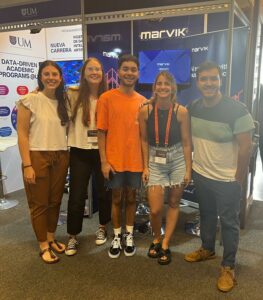 Ilana, María Noel, Anthony, Sofía, and Martin from our team at Marvik’s booth
Ilana, María Noel, Anthony, Sofía, and Martin from our team at Marvik’s booth
All talks are available online at Khipu’s official site. The aim of this post is to provide a summary of the most popular topics discussed at Khipu, along with key takeaways and insights.
NLP: The era of LLMs
In the field of Natural Language Processing (NLP), Large Language Models (LLM) have shown significant progress in the last years, making them one of Khipu’s most recurrent topics.
Professor Kyunghyun Cho started with a lecture on LLM fundamentals, during which he covered several relevant topics such as Attention Mechanism, Transformers, and Auto-regressive Seq2Seq models. Also, he identified Spurious Correlation as one of the key challenges in LLM, which needs to be mitigated in order to gain robustness in the models.
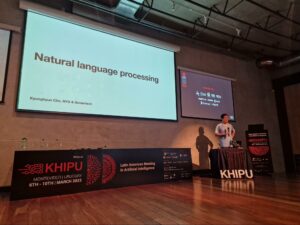
Keynote talk given by Kyunghyun Cho
Nando de Freitas complemented this with a lecture on Multimodal Transformers and Mask Language models applied to images, reaffirming the importance of incorporating other information sources rather than text (images, sounds, etc.) in order to gain even better results.
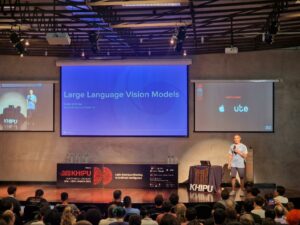
Keynote talk given by Nando de Freitas
Moreover, during one of the parallel sessions, Maria Lomeli from Meta Research gave a very interesting talk on the use of Retrieval Augmented Language Models (RALM) as an alternative to LLMs. These models allow to gain explainability and have the ability to identify sources of information from which the output is generated. In particular, she introduced ATLAS, a retrieval model which involves significantly lower computational cost than LLMs while maintaining decent results in few-shot learning tasks.
Finally, during the research talks, we had the opportunity to listen to some of Latin America’s top researchers share their current work in the field of NLP. One of the most interesting topics presented was the incorporation of underrepresented languages such as Guarani and other indigenous dialects into the NLP world. Mainly, all the speakers shared the common thought that there is a need to raise awareness of the lack of non-english models available and that this is a field that needs to be exploited further in order to democratize the use of NLP in society.
Generative Models
There were several talks and one practical session concerning generative models (GMM), as they are nowadays a relevant type of artificial intelligence due to their ability to generate high-quality realistic data. At the conference, a wide range of topics related to these models were covered, from their theoretical foundations to various practical applications including image, video, and audio generation.

Keynote talk given by Ruben Villegas
The main talk on generative models was given by Ruben Villegas, Research Scientist at Google Brain. In his talk he focused on the generation of images and videos, discussing most popular diffusion and transformer based models and highlighting their differences, advantages and disadvantages. He also gave multiple examples of GMM in various fields such as Phenaki, a model to generate videos from text for which he contributed, and MusicLM, a model to generate music from text.
In addition, many applications of generative models were presented throughout the parallel sessions and the sponsors and spotlight talks. On that note, our CEO Paula Martinez presented some of the things we have been working on here at Marvik using generative models for virtual try on.
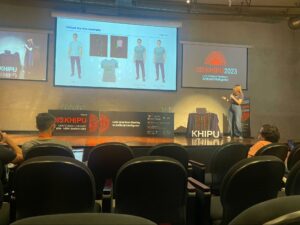
Sponsor talk given by Paula Martínez
Reinforcement Learning
During the conference, Reinforcement Learning (RL) stood out as another frequently discussed and referenced topic. Two keynote presentations were given on this subject as well as a practical session and a parallel session with RL experts.
Pablo Castro gave an excellent introduction to Reinforcement Learning, covering the basic principles and concepts that form the foundation of RL such as Markov Decision Process (MDP), Random Policy Search, Policy Gradient, Q-Learning and exploration-exploitation trade-off. Some of these topics are covered in greater depth in Pablo’s blog which is available both in English and Spanish. Also there is a colab notebook available for further practice.

Keynote talk given by Pablo Castro
During the parallel sessions, several case-studies from DeepMind and Google Brain were presented showing the cutting-edge progress in this field, as well as current challenges yet to be resolved in the area. In particular, the use of LLMs in the process of action selection was mentioned as one of RL hot topics.
Graph Neural Networks
Over the years, Graph Neural Networks (GNN) have proven to be an important player in the field of ML, and are likely to keep being central in a wide range of applications in the future. The first lecture on this subject was given by Alejandro Ribeiro, who gave a glance at some of the main themes covered on his current course at UPenn.
In scenarios where a graph is a key component in describing relationships between elements, the importance of using GNNs arises. GNN manages to leverage the use of structural information and capture complex patterns by aggregating information from neighboring nodes and edges, and using this information to update node representations. This cannot be done easily with traditional ML algorithms.
Alejandro introduced the concept of graph convolutional filters as a way of generalizing usual convolutions applied in graphs. Or in other words, thinking of GNNs as a generalization of Convolutional Neural Networks (CNN). Another interesting property that was covered is transferability. GNNs are able to generalize well to unseen data and so they can be applied to other graphs that differ in structure, size, and characteristics from the training set. The transferability of a GNN is an important characteristic as it determines the practical usefulness of the model for real-world applications.
A second lecture was given on this matter by Gonzalo Mateos. He presented the advantages of using GNNs in a vast variety of applications such as recommendation systems, agent interactions in multiagent robotics, wireless communication network systems and knowledge graphs, to name a few. During the lecture he also talked about graph representation learning and shallow embeddings, going through several techniques such as matrix factorization, random walk based representation techniques and node2vec.
Ethics and Fairness
The field of Artificial Intelligence has the potential to bring about great benefits for society, but it also raises important ethical and moral questions. In recent years, there has been growing concern about the impact of AI on society, particularly around issues of fairness, accountability, and transparency. At the Khipu Conference, several talks were dedicated to exploring these issues and discussing possible solutions to ensure that AI is developed and used in a way that is ethical, responsible, and fair.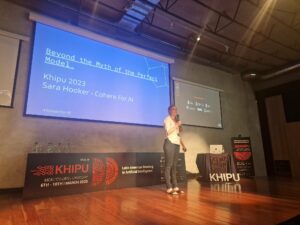
Keynote talk given by Sara Hooker
In particular, Sara Hooker Director at Cohere gave a spectacular talk on this topic which provided the attendees a general feel of the field of Ethics and Fairness in AI. Additionally, she talked about Cohere For AI, a non-profit research lab focused on creating more points of entry into machine learning research.
Practical Sessions
In addition to the keynote speeches and research presentations, the conference offered practical sessions that allowed attendees to gain hands-on experience with the latest AI tools and techniques. These practical sessions were led by experts in the field and provided participants with valuable insights into the practical applications of AI. In this section, we will provide an overview of the practical sessions offered at the conference, including the topics covered and the tools used. The notebooks for these sessions can be found through this link.
- Introduction to JAX: This tutorial covered JAX, Optax, and Haiku, which are high-performance libraries for computation, optimization, and model learning. Additionally, it introduced Convolutional Neural Networks (CNN) and demonstrated how to use the tools mentioned to train a deep convolutional model.
- Attention and Transformers: This practical session was offered by members of the Hugging Face team. In it the attention mechanism was introduced in greater detail and a transformer was built block by block to see why it is such a robust and powerful architecture.
- Graph Neural Networks: This tutorial covered Graph Neural Networks (GNNs), which have gained immense popularity in both research and industry. It included a refresher on graph theory, an overview of how GNNs work, and a discussion of popular GNN implementations with practical examples.
- Deep Generative Models: This practical focuses on Generative Models. Specifically, it walks through the development challenges of a Denoise Diffusion Model, which is the backbone of recent models like Dalle-2 and Imagen.
- Intro to Reinforcement Learning: This introductory tutorial explains Reinforcement Learning (RL), where an agent learns to take actions to maximize rewards in an environment, covering various RL approaches for solving the classic CartPole problem.
- Social Impacts of Artificial Intelligence: This practical focused on assessing the impact of stereotypes on language technologies and understanding biases in large language models and word embeddings.
Poster Sessions
The conference also featured a poster session where attendees could present their research in a more informal setting. This allowed for a more interactive experience where researchers could discuss their work with other attendees and receive feedback on their findings.
The poster session covered a range of topics related to Artificial Intelligence, including Deep Learning, Computer Vision, Natural Language Processing, and more. It was a great opportunity for attendees to learn about cutting-edge research and network with other professionals in the field. The abstracts for all the posters presented during the conference can be found in this link.
Additionally, Ilana Stolovas and Maria Noel Espinosa, members of our team, presented part of their undergraduate thesis during the poster session under the title “Audio tagging for anthropogenic impact assessment on Antarctic soundscape”. Several attendees were impressed with their work, and they received valuable feedback and suggestions from other researchers. It was a great opportunity for our team members to showcase their expertise and gain exposure to the broader AI community.

María Noel from our team with her poster on audio tagging on Antarctica
Women in AI
On day 4, Google organized a Women in AI event to unite women and to discuss, encourage and support the importance of diversity in the AI community in Latin America. During the event a prestigious group of panelists from academia and industry shared their career experiences and their personal journey through the AI world. We are very proud that one of our own, our CEO Paula Martinez was invited to join this panel of magnificent women.
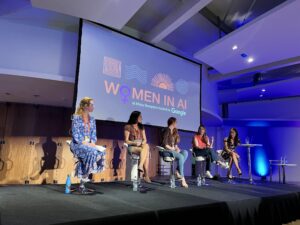
Panelist of Women in AI event
All members talked about what experiences led them to the field, what persons or events inspired them and led them to enhance their careers. They also shared their perspectives and advice to those women who are to come. In particular, one of Paula’s messages was about the fact that the AI industry is constantly changing, and how important it is to not be overwhelmed by this and understand that sometimes it will be impossible to be on top of all the latest advances but that is ok! It is important to know when to stop searching and start creating.
Definitely, it was a very enriching space full of exchange and personal growth, centered on the key message that diversity in AI should not be solely a concern for women as it has an impact on everyone. It is imperative for all of us to take action and keep moving towards a more inclusive community.
Finally, the event closed with an incredible show by one of the most famous Uruguayan bands, No Te Va Gustar, who shared a little bit of our country’s rock culture.
Closing Event
The Khipu 2023 Closing Event was held at beautiful Teatro Solís on March 10th, and it was an exciting and free event that hosted talks by renowned researchers in Artificial Intelligence. The event was open to the general public, academia, press, industry, and collaborators, and attendees had the opportunity to hear from leading researchers on recent AI applications in Latin America and the world.

Teatro Solís at closing event
The attendees were warmly welcomed to the venue while two talented young programmers demonstrated their skills in live coding. This is an improvisational performing art that involves writing source code to generate images or audio while projecting the computer screen in the audience space, allowing the audience to see the process of code creation in real-time.
Then, a series of talks were given by six different researchers presenting multiple topics. Later, Peter Norvig, American Computer Scientist and Distinguished Education Fellow at the Stanford Institute for Human-Centered AI, gave the keynote talk. After that, a panel of seasoned AI researchers provided different perspectives on regional collaboration possibilities in Latin America. Finally, the attendees shared a well deserved brindis outside teatro Solís to give an end to an awesome week.
Final thoughts
To conclude, the Khipu 2023 conference was an absolutely amazing event and we at Marvik are incredibly proud to have been sponsors. The conference brought together some of the brightest minds in the field of Artificial Intelligence, and attendees were treated to a wide variety of exciting talks, workshops, and panel discussions.
From the cutting-edge research presented in the main sessions to the poster sessions, the conference was a celebration of everything that makes AI such an exciting and dynamic field. We are already looking forward to the next Khipu conference and can not wait to see what amazing things will be on offer!
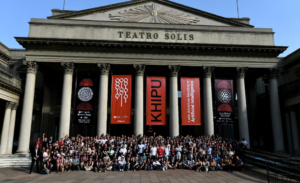
Khipu 2023 attendees at closing event

